History
World Friends began from an initiative of Gianfranco Morino, a medical doctor with more than 35 years’ experience in Africa. After having collaborated for a number of years on projects with the Italian Cooperation for Development, in 1991 he took on responsibility with the Programme for Health Prevention and Education in the nomadic area of Sololo, North Kenya, collaborating with the UN High Commissioner for Refugees. Following work with the European Union in Somalia, in 1994 he began to work in health prevention and education in the shanty towns of Korogocho and Mathare in Nairobi. In 2002 he then took over the direction of the Department of Surgery at Mbagathi Hospital, still in the Kenyan capital, being the only European to work in a state-run hospital.
In 2001, together with a group of friends and collaborators, all convinced of the need for an association to be created in Africa itself, Morino established "World Friends - Amici del mondo". The central idea was that of an organization that could properly integrate with the reality of the local population, not being thousands of miles away, and able to carry out projects deriving from the concrete needs of these populations. To respond to that need, World Friends has over the years prioritized the use of local personnel, relying minimally on the services of expatriate personnel.
Projects
The objective of all World Friends projects is to promote health, education and social development of the most disadvantaged populations in the south of the world. World Friends is active in Kenya, Tanzania and Ethiopia, meeting the needs of the local populations and with their full involvement. The ultimate goal remains to encourage self-sufficiency in the communities where the Association works, and it is for this reason that World Friends makes use above all of local personnel for its activities in Africa, contributing to their professional training. [3]
An example of World Friends approach is the construction of the Ruaraka Uhai Neema Hospital, a multi-functioning health centre opened by World Friends in November 2008 Inauguration of R.U. Neema Hospital. Situated near to the shanty towns of Nairobi the hospital treats more than 10,000 patients per month, thanks to a staff composed of 99% local personnel. The Ruaraka Uhai Neema Hospital dedicated not only to the treatment of the poorest sector of the population but also to the training of local medical personnel. This action will go on further to consolidate the work carried out by World Friends at the Mbagathi Hospital and at the surgeries located in the Nairobi shanty towns. In addition to health assistance, World Friends workers carry out action in the field of health prevention and education, above all to combat the spread of the HIV virus. Services offered by the hospital: General clinic and Maternal-Infant Clinic with vaccination services, gynecology and pediatrics; Maternity Department with operating theatre; Diagnostics Centre offering laboratory tests, radiography and echography. Accident & Emergency, minor surgery and day hospital; HIV tests and treatments; Physiotherapy and Occupational Therapy; Pharmacy; Ambulance service; Centre for Professional Training; Pediatrics Department.
Since its inception in 2001, the association has focused its plan of action on achieving the eight Millennium Development Goals, approved by the 193 member States of the United Nations for world development, to be achieved within 2015. Today, the new challenge are the Sustainable Development Goals to which all countries are called upon to contribute to bringing the world to a global, economic and social sustainability path without distinction Between South and North. Our new goal is therefore the 2030: World Friends will not only continue to work against poverty in the South of the planet, expanding its collaboration with other communities in Africa and Latin America, but will also bring programs and experience in the suburbs of the North of the World, where injustice, inequality and the lack of rights are increasingly accentuated.
Context
World Friends works mainly in the sub-saharian countries of Africa, such as Kenya, Tanzania and Ethiopia. The projects of World Friends are mainly focused on populations in the shantytowns in the north - east area of Nairobi (Korogocho, Kariobangi, Babadogo, Mathare Valley - Eastleigh, Huruma, Kahawa, Soweto).around 700,000 people, half of whom are under 15 years of age.
The beneficiaries of World Friends’ projects come from backgrounds marked by poverty, violence, criminality, prostitution, the precariousness of housing and work, pollution, diseases. The health problems found by the health workers of World Friends are innumerable: gastroenteritis and severe respiratory diseases, especially in children; a permanent status of malnutrition and the presence of typhoid fever and malaria. Tuberculosis is in evident recrudescence; the number of children with physical handicaps is high. The diagnosis of ailments requiring surgery and the incidence of cancer – the latter showing a clear increase – is often delayed due to the intrinsic inefficiencies of the health systems in African countries. The lack of specialist services for diagnosis and treatment accessible to the poor worsens the outcomes of traumas and burns, very frequent among children, often causing permanent disabilities in a context where physical integrity is linked to the survival of the individual. The transmission of sexual diseases is very widespread, AIDS in particular being a very real scourge.
Regarding trends for the rest of the city and for the country, access to reproductive health services in the Nairobi slums is minimal: only 15% of the health structures present provide basic obstetrical assistance and only 35% of the births are assisted by qualified personnel. Maternal mortality in the shanty towns (590 mothers per 100,000 births in 1998) [4] is higher than in any other region in Kenya. The infant mortality rate under 5 years of age (1,565 deaths for every 1000 babies, equal to 15.6%) [5] is higher than that of any other urban settlement in Kenya. Lastly, because the incidence off AIDS is decreasing at the National level, in the Nairobi slums adolescents and women are still strongly vulnerable, with 37% of women between 20 and 24 years of age resulting positive to the infection. [4]
Networks
World Friends works in collaboration with many other bodies in Italian and international cooperation: CONCORD Italia Platform, Italian Observatory for Global Action against AIDS, Global Health Center of the Tuscany Region, Since 2016 World Friends is a member of LINK 2007, one of the three main networks representing NGOs nationwide. World Friends is part of regional networks that unite profit and non-profit realities, public bodies, universities and experts, thanks to the activities of local offices and volunteers. These realities work to systemize and strengthen local activities of international cooperation, the development of territorial cooperation and awareness raising in Italy. The most active are the Tuscan Forum for International Activities, the Coordination of Piedmont NGOs, the Janua Forum, the Ligurian Network for the Promotion of International Activities. Nairobi's headquarters and association projects are constantly a place to visit by delegations from various organizations and by volunteers, interns and practitioners. World Friends is a member of several networks including: Hennet - Health NGOs Network, a NGO consortium and Kenyan and international institutions operating in Kenya in the field of healthcare; Action for Children with Disabilities (ACD), Nairobi Child Protection Network (NCPT), Elimu Yetu, Kasarani Genver-Based Violence Forum.
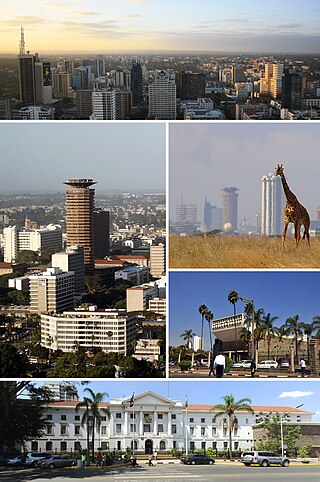
Nairobi is the capital and largest city of Kenya. The name is derived from the Maasai phrase Enkare Nairobi, which translates to 'place of cool waters', a reference to the Nairobi River which flows through the city. The city proper had a population of 4,397,073 in the 2019 census. The Greater Nairobi Metropolitan Area has a population of about 7,000,000 people. The city is commonly referred to as The Green City in the Sun.

A slum is a highly populated urban residential area consisting of densely packed housing units of weak build quality and often associated with poverty. The infrastructure in slums is often deteriorated or incomplete, and they are primarily inhabited by impoverished people. Although slums are usually located in urban areas, in some countries they can be located in suburban areas where housing quality is low and living conditions are poor. While slums differ in size and other characteristics, most lack reliable sanitation services, supply of clean water, reliable electricity, law enforcement, and other basic services. Slum residences vary from shanty houses to professionally built dwellings which, because of poor-quality construction or lack of basic maintenance, have deteriorated.

A shanty town, squatter area or squatter settlement is a settlement of improvised buildings known as shanties or shacks, typically made of materials such as mud and wood. A typical shanty town is squatted and in the beginning lacks adequate infrastructure, including proper sanitation, safe water supply, electricity and street drainage. Over time, shanty towns can develop their infrastructure and even change into middle class neighbourhoods. They can be small informal settlements or they can house millions of people.
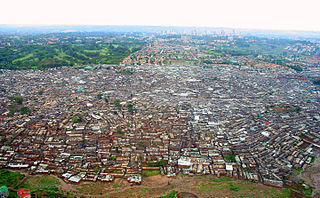
Kibera is a division and neighbourhood of Nairobi, Kenya, 6.6 kilometres (4.1 mi) from the city centre. Kibera is the largest slum in Nairobi, and the largest urban slum in Africa. The 2009 Kenya Population and Housing Census reports Kibera's population as 170,070, contrary to previous estimates of one or two million people. Other sources suggest the total Kibera population may be 500,000 to well over 1,000,000 depending on which slums are included in defining Kibera.

Pharmaciens Sans Frontières Comité International (PSFCI) is the largest humanitarian association in the world specialized in the pharmaceutical sector. Founded in 1985 to retrieve unused drugs from chemists for use in developing countries, PSFCI extended its objectives to help developing countries set up a locally adapted health care system.
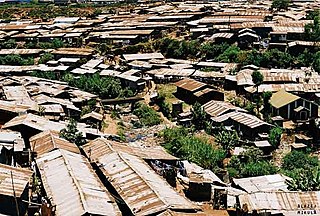
Founded in 2001 by Rye Barcott, Salim Mohamed, and the late Tabitha Atieno Festo, CFK Africa is an international non-governmental organization (NGO) based in the informal settlement of Kibera in Nairobi, Kenya. Registered as an NGO in Kenya and a 501(c)(3) in the US, CFK Africa is a pioneer of grassroots participatory development, and leads a community-based sports program, girls' empowerment centre, medical clinic, maternity centre, nutrition centre, young health and wellness centre, community-health outreach program, scholarship program, entrepreneurship and economic development initiatives, and a research-based initiative to improve educational quality in informal schools in Kibera. FK Africa is also an affiliated entity at the University of North Carolina at Chapel Hill and has an office at the university.
Kuki Gallmann is an Italian-born Kenyan national, best-selling author, poet, environmental activist, and conservationist.

Mathare is a collection of slums in Nairobi with a population of approximately 500,000 people; the population of Mathare Valley alone, the oldest of the slums that make up Mathare, is 180,000 people. Mathare is the home of football teams Mathare United and Real Mathare of the MYSA. Mathare is currently part of two electoral constituencies; the titular Mathare Constituency and the northern part being in Ruaraka Constituency. The northern part was initially part of Kasarani Constituency up to the 2013 elections when Kasarani was split into three electoral constituencies; Ruaraka being among them. The southern part was domiciled in Starehe Constituency.

Mathare Valley is a part of Mathare slum in Kenya. It is in the Nairobi area. Other informal settlements in the Nairobi area include Huruma, Kiambiu, Korogocho, Mukuru and Kibera. It has a high population density. It is a few kilometers from the centre of Nairobi. The Mathare River flows in the valley.

Tropical diseases, especially malaria and tuberculosis, have long been a public health problem in Kenya. In recent years, infection with the human immunodeficiency virus (HIV), which causes acquired immune deficiency syndrome (AIDS), also has become a severe problem. Estimates of the incidence of infection differ widely.
KICOSHEP, the Kibera Integrated Community Self-Help Programme, is an NGO founded by Anne Owiti in a sparse dingy clinic within the shanty settlement of Kibera in 1991. The majority of patients were diagnosed with HIV/AIDS related ailments, revealing the impact and spread of HIV/AIDS within the Kibera community and confirming the recent discovery that Kibera slum records the highest HIV/AIDS prevalence rates in Nairobi.

Korogocho is one of the largest slum neighbourhoods of Nairobi, Kenya. Home to 150,000 to 200,000 people pressed into 1.5 square kilometres, northeast of the city centre, Korogocho was founded as a shanty town on the then outskirts of the city.
South B is the name of a Division of the sub-county of Starehe in Nairobi, Kenya and the name of a "sub-location" of Mukuru Nyayo within the Division. The 2019 Kenya Census gives a population of 102,441 for South B Division and 34,216 for the sub-location. South B is about 3 kilometres (1.9 mi) south-east of Nairobi Central Business District; the Industrial Area lies to the east and the South C district to the south-west.
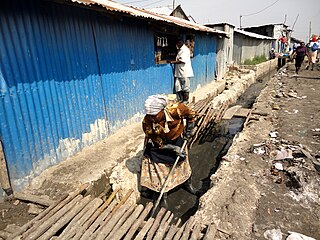
Mukuru Kwa Njenga is a slum in the Mukuru slums of Nairobi. Mukuru kwa Njenga is among other villages in Mukuru namely; Mukuru kwa Reuben, Mukuru kwa Njenga, Sinai, Paradise, Jamaica, Kingstone, Mariguini, Fuata Nyayo and Kayaba. The population exceeds 100,000.
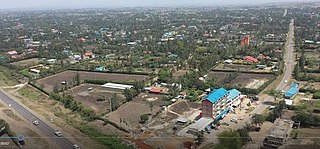
Kamulu is a neighbourhood in Nairobi City County located to the North East of the Nairobi Central Business District (CBD). It borders Joska (Matungulu) in Machakos County to the east, Mwalimu Farm Ruiru to the north, Njiru to the west, and Mihang'o to the south west.
The 2011 Nairobi pipeline fire was caused by an explosion secondary to a fuel spill in the Kenyan capital Nairobi on 12 September 2011. Approximately 100 people were killed in the fire and at least 116 others were hospitalized with varying degrees of burns. The incident was not the first such pipeline accident in Kenya, with the Molo fire of 2009 resulting in at least 133 fatalities and hundreds more injured.
Stellah Wairimu Bosire, is a Kenyan physician, corporate executive, human rights activist and author, a former co-executive director of Uhai Eashri and previously served as the chief executive officer of Kenya Medical Association and as the vice-chair of the HIV and AIDS Tribunal of Kenya.
Viwandani is an informal settlement in the city of Nairobi, Kenya. It is an electoral ward within the Makadara Constituency of Nairobi County. It borders on the Nairobi Industrial Area. The name "Viwandani" means "at the industrial zone" in Kiswahili. There are thirteen "villages" within the settlement: Jamaica, Kingstone, Lunga Lunga Centre, Lunga Lunga Donholm, Milimani, Paradise A, B, and C, Riverside, Sinai, Sinali Reli, Tetrapak, and Uchumi.










